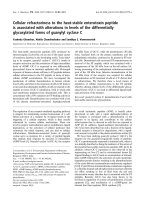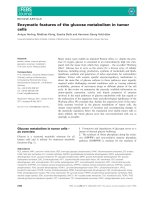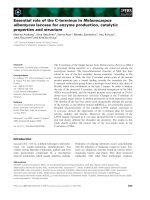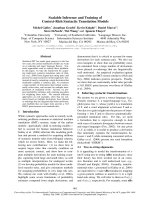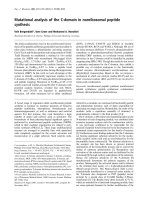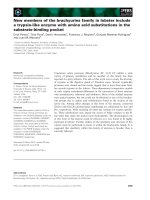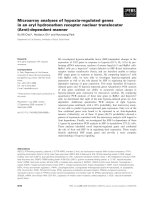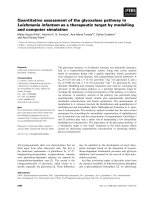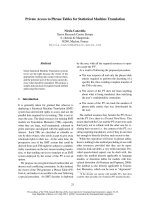Báo cáo khoa học: "EXTENDED ACCESS TO THE LEFT CONTEXT IN AN ATN PARSER" pptx
Bạn đang xem bản rút gọn của tài liệu. Xem và tải ngay bản đầy đủ của tài liệu tại đây (574.23 KB, 8 trang )
EXTENDED ACCESS TO THE LEFT CONTEXT IN AN ATN PARSER
Irlna Prodanof and Giaeomo Ferrari
Istltuto di Linguistica Computazionale
Via della Faggiola 32
1-56100 Pisa, Italy
ABSTRACT
Some Italian sentences related to linguistic
phenomena largely known and recently discussed by
many computational linguists are discussed in the
framework of AT:~. They offer certain difficulties
which seem to suggest a substantial revision of
the ATN formalism. The theoretical assumptions and
an experimental implementation of such a revision
are presented, together with examples. }:any
related theoretical points such as some
psyeholinguistic implications and the relationship
between deterministic and non-deterministlc
hypothesis are also briefly discussed.
I. INTRODUCTION
Certain types of sentences seem to defy the
abilities of several parsers, and some of them are
being now discussed by many computational
linguists, mostly within the deterministic
hypothesis.
An exmaination of their treatment within the
traditional AT[: paradigm seems to suggest that the
real discussion is about how to acces the left
context and what its form should be.
II. ACCESS TO T}]E LEFT COfJTEXT
occurs, the parsing algorith~ suspends the current
computation and starts a new level of computation.
Usually, each network recognizes some linguistic
unit such as Noun Phrase (NP), Prepositional
Phrase (PP), and Sentence (S) and any recursively
embedded call to one of them corresponds to a
level of computation.
The parsed parts of the input string are
stored (SETRed) into registers as they are
recognized. At the end of the network these
registers are combined (BUILDQed) into a parse
node and returned (POPed) to the calling net.
Appropriate functions can return the content of a
register (GETR) or transfer it to another register
(combination of SETR with a GETR). This last
operation is equivalent to i) the renaming of a
register, if the source register is successively
set to a different value, ii) the initialization
of a register at a lower or higher level, if SENDR
or LIFTR are used.
Initialization is co~aonly used to i) raise
lexical features to a higher level where they are
used for tests (ex.: subject-verb agreement), ii)
pass possible antecedents to lower levels where a
gap may be detected in an embedded clause.
B. Difficult access to registers
i. Filler-gap linking
The antecedent passing
theoretically unlimited increase
By the standard procedure, the
m~biguous sentence(1)
may cause a
in storage load.
analysis of the
(I) Giovanni disse che aveva mentito
John said that (he) had lied
A. ATN Grammars "Giovanni" is always SENDRed as possible SUBJect
of a complement, as soon as "disse" is recognized
An ATN grammar is a set of networks formed by as an STF~ENS verb. As no subject NP is met after
labelled states and directed arcs connecting them. "che', an interpretation is yielded with
The arcs can rlco~nize terminal (words) and "Giovanni" in subject position. The second
non-temnlnal (lexical cateF, ories) s~anbols or interpretation is produced si,,ply by successively
reeursively call for a network identified by the setting the SULqJ register to a d~;~my node, which
label of an initial state. When such a call
(i) The ambiguity of this sentence is the sa1:~e as its English translation where "he" can be bouud either
to "John" or to soueone else ,~eutioned in a previous sentence. Italian has a gap instead of a pronoun.
58
remains unfilled. The same treatment is
recursively applied to sentences llke
(2) Giovanni pensava che avrebbe raccontato
John thought that (he) would have told
a tutti che aveva fatto una
to everybody that (he) had done a
scoperta
discovery
where "Giovanni" must serve as subject of both the
first and the second (linearly) complement.
Instead, in the sentence
(3) Giovanni dlsse che i suol colleghl avevano
John said that his colleagues had
mentito
lied
2. Lexieal features raising
A storage overload may also be caused by the
need for raising lexieal features. ~orphological
features are necessary at the least in the test of
subject-verb agreement. This is done by LIFTRIng
in ad hoe registers gender and number from the NP
level to the S level. If the :;P is popped in a
possible subject position the test for agreement
may take place by comparing the content of those
registers with the corresponding features of the
verb. However, there are cases such as ex.(1) in
which such information must be used again in the
course of the analysis for another (agreement)
test. Those features must be~ therefore, copied
in appropriately labelled registers in order to i)
flag their relation to the subject and ii) prevent
theln from being erased when the s~ne features are
LIFTRed from the following NP.
as the ~:P "i suoi colle~;hi" is analysed, it
replaces the SENDRed "Giovanni" in the SUBJ
register and the correct interpretation is popped.
The same need for ad boc storing may be shown
for the object and few PP complements. For
example, in the sentence
A more complex treatuent is required for the
sentence
(4) Giovanni pensava che i suoi colleghi avrebbero
John thought that his colleagues would
raccontato a tutti che aveva fatto
have told to everybody that (|.e) had done
una scoper ta
a discovery
where "Giovanni" must get through the first
complement and reappear in the second (embedded)
one. If SENDR is used, a transit re~ister RI with
the same content as the initialized SUBJ register
is to be passed down together with it. When the
subject of the first complement ('i suoi
colleghi') is found, it replaces "Giovanni" in
SUEJ but not in RI. The new SUBJ "i suoi
colleghi" and RI "Giovanni" are again SENDRed to
the embedded complement where the agreement with
the verb correctly selects, as subject, the
content of RI. l~ow, as the number of levels which
to "jump over" is in principle illlmited and each
one uay have its own subject to be SENDRed, a
tra~Isit register for each new subject is needed.
Thus, for the sentence
(5) Giovanni era sicuro che i suoi ner,lci
avrebbero rivelato alla stamps che sua moglie
avers detto un ;~iorno che l'aveva picchiata(2)
(6) Ii capitano disse ai soldati che
The captain said to the soldiers that
marciavano pietosamente
(they)
were marching peatifully
as the t!P "i soldati" embedded in the "a-PP" is
the subject of the complement, its gender and
nu~iber must travel up through PP and S and down to
the complement, in order the subject-verb
agreement to be satisfied. This implies that at a
given moment other registers containing
morphological features coexist at the S level with
those of the subject.
An obvious remedy to this proliferation of
registers consists in adding these features to tile
tiP or PP structure, POPing them, and extracting
them from those structures when needed. But
classical ATN does not provide a suitable
function, a form that should return only a part
of a stored tree after having searched through it.
Now, although such functions are not particularly
complex to design [5, 7], they are not perfectly
consistent with the ATe( general formalism which
does not take into consideration the extraction of
pieces of already processed information from the
structure they have Deen inserted in.
C. A functional perspective
when ?recessing< the last corn ple~,~ent three
re:~isters contaizling the three possible subjects
will be available and shall be visited in order to
find the ri~iht one(3).
i. A generalized retrieving action
If we look at the discussed exa,,;ples free an
entirely functional viewpoint ~Je can describe them
as having in common the need for retrieving
(2) *John was sure that his enne~,ies would have disclosed to the press that his wife had once told tha't
(he) ha.:! bested her*. ~,'e give here, for clarity, the parenthesized form of this exmuple:
(Giovanni era sicuro (che i suol nemlei avrebbero rlvelato alia stamps (ehe sua moglie aveva detto un
glorno (che l*aveva picchiata))).
I!otice that in this example the subject-verb agreement is sufficient to select the right antecedent, but
t|'is is not always the case.
(3) A possible alternative, equally trlcky,is the use of the HOLD-VIRT couple.
59
information somewhere back in the already built
structures; the tricky solutions presented above
are, in fact, a way of accessing parts of the left
context. These sometimes correspond to the entire
content of a register and sometimes to a fragment
of it.
We will assume, then, that the left context is
stored in a space of memory, equally accessible
from any level and that retrieving always concerns
fragments of it. At any point of the process this
structure contains the current hypothesis about
the analysis of the parsed segment of the input
from the beginning; hence we will refer to it as
Current Global Hypothesis (CGH).
The retrieving action will have two participants,
a symbol that triggers the action (trig£er) and
the infomnation to be retrieved (the target of the
action).
In this frame all the different procedures
discussed above may be reduced to a single general
algorithm of three steps,
i) identification of a trl~er (a gap to be
filled, a verb uhich demands for the subject-verb
agreement test)
ii) extraction of constraints which ::~ust guide the
search for the target, and
iii) retrieving of the required inforuation.
On this functional ground, the same
description fits to the binding of an anaphoric
pronoun to its antecedent [7] as in
(7) a) Giovanni disse a harla che voleva
John said to .~ary that (he) wanted
sposarl-la
marry her
as opposed to
b) Giovanni dlsse a llaria che voleva
John said to ~!ary that (he) ~lanted
sposarsi
to marry
The function that searches back may be
constrsined by several types of restrlctlons,
includin~ i) morphological features, i.e. the
gender and number of the pronoun or those required
for agreement by the syntactic environment (e.g.
the verb), ll) syntactic idiosyncrasies of soue
lexical Ite~:~ such as the STRA~S verbs that
determine which of their arguments is to be the
subject of the couplement, ill) seLlautic features
that may be introduced in the process, and iv)
syntactic deter, inat ion of the scope of the
search.
2. .!anipulations of the left context
I[et rieving of the antecedent nay actually
correspond to two different operations depending
upon ~hether the antecedent to be bound li~Learly
preceeds or follows the syubol it is to be bound
to.
In the cases discussed abovu the gap or the
pronoun always follow there antecedent and it is
therefore possible to i~ ,:~edia tel y insert the
binding pointer. [[oreover, in many comon sentences
the antecedent linearly follows its dependent, as
in
(8)
(9)
Quando si arrabbia, Giovanni diventa rosso
When (he) gets angry, John becomes red
Se io vedi, saluta Giovanni
If (you) see him, say hallo to John
da parte mia
on my behalf
In this case, the binding should take place in
two steps, the flagging of the need for a forward
binding and the moving of the pointer from the
antecedent, once detected, to the flag. Notice
that this class of sentences entirely lies beyond
the abilities of the classical ATi~ framework.
Relative pronouns also need to be bound to an
antecedent and, besides, are the surface signal of
an embedding. ~:o special processing difficulty is
proposed by sentences like
(i0) Ii ra~azzo ehe corre
The boy who runs
where the relative pronoun occurs exactly ~here
the embedding begins. In this case a scope
restriction can limit the search for an antecedent
to the imI.~ediately preceeding [~P.
But in the sentences
(ii) II ragazzo del quale ti parlmvo
The boy about whom I was talkin3 to you
(12) Ii ragazzo del cui padre ti parlavo
The boy about whose fati~er I uas talking
to you
the relative clause boundery is set one word
before the relative pronoun, and in
(13) Ii ragazzo del padre del quale
The boy about the father of whom:
ti parlavo
was talking to you
where the phenomenon known as pied-plping occurs,
such a boundery may be located several words
before the relative pronoun.
In an AT!~ these cases ~:eet the initial set of
arcs ~hich recognize a PP e~,bedded iu an NP, as iu
(14) il ragazzo dell'nscensore
t~e boy of the lift
anti the correct interpretatiot~ is obtained only by
backtracking (for ii and 12) aad again usinb a set
of transit registers (for ]2). ~o solution is
known for sentence (13).
In the frame~'ork we have been discussin,~ an
action ~Jhich structurally ~iodifies the left
context can be proposed. It should e~,:Sed the
c~llponent(s) being: [,rocessed in a relative clause
as the relative pronoun in met.
60
A third type of access to the left context is
the relabelling of a processed component, already
used for the passive transfon~ation.
III. EXPF.~ I~IE,~TAL I~d'LEF,'ENTATIO;I
A. General assumptions
[~ost of the above discussion is based on our
own experience with an ATN parser, although valid
also for other parsers. Some of the linguistic
phenomena we are trying to functionally classify
have been recently discussed in the frame of the
detenainistic parsing and sou, e progress in the
treatment of those sentences has been done.
However ~Je prefer to stick to the
non-deten:~inistic hypothesis, because no valuable
ar~;ument seems to stand against ti~e idea of AT~ as
a collection of alternative heuristic strateEies
representing those used in the human sentence
processing. On the contrary it is possible to
introduce in an ATN parser some mechanism for
selecting strategies in function of a text or a
sublangua;~e [Ii].
Our assumption is, then, that
the
possibility
of backtracking must be kept, but restricted by
i. introducing linsuistic coDstraints to guide the
choice of alternatives;
ii. manipulating the left context in some cases in
which backtracking can be intuitively charged on
inadequacies of the parser rather than on points
of real linguistic ambiguity.
A second assumption more related
to the
current implementation of the system refers to the
grammatical fomnalisn. A functional representation
a la [' Kay [i~] is used. A detailed explanation
of this fonaalis:~ is not necessary to the
understanding of this paper. It is enough to know
that its ];asic unit is the attribute-value pair,
wk,ere an attribute is a symbol (label) and a value
is a symbol or another functional description. In
the sentence
(15)
lle
killed her
a possible pair is SUEJ=he, or SUBJ=HEAD=he
together with SUBJ=CAT=PRON etc. Any sequence of
sy~nbols is a path leading to a value; thus the
value of SUI;J=:IEAD is "he'.
The functions that access the data structure
are specifically desi.~;ned to treat this type of
representation but ~.,e think that they could be
easily Feneralizcd. The ter-n "component" will be
used to identify the get of paths startin;; fro,~
the sa:ae lal;el (radix).
The reasons of this choice are as follows:
i. addressim: frabments of information is more
easily done by follo~,In~: a path of labels than by
visiting; a unlabellcd tree;
ii. functional grammar allows any depth of
linguistic representatiou through the left
adjunction of labels;
iii. functional syntactic repeseutation and
lexical features (also expressed in tenas of
attribute- value pairs) ;~ay be treated in a
uniform way.
B. The parser
The basic features of the ATN :~,arser used in
our previous experi~aents [19], i.e. the network
formalism and the parsing algoritl~a, are kept,
while the data structure and the whole set of
actions and forms have been modified. Also the use
of the push-down mechanisn~ has been ,modified to
some extent.
The data structure is a list which is mainly
accessed wittl a typical LIFO stack policy. It
represents a unique memory space non splitted into
registers. The state saving mechanism necessary
for the treatraent of non-detenainism is provided
by XD-LISP [2,17], the dialect of LISP in which
the system is written. At any point in which
non-determinism is called, the previous context,
in particular the data, is saved and only the new
values are set in the current context. Therefore,
there is no difference between the use of the
traditional register table and this special list
since both of them are handled in the same way.
This (LIFO) list contains at any point of the
process the CGI', i.e. the entire left context
literally represented in ten,~s of attribute-value
pairs.
We give hereafter a llst in Backus notation of the
functions which access the CCH.
I .Actions
a. <storing actions>::=
ADD pair location ]
ASSIGN label path
<location>::= NIL ] <farad>
<label>::= any label
<pair>::= label value
<value>::= * [ <fen|>
b. <list manipulation>::=
PUSU I
PoP l
INSERT data item
<data>::= any data
<item>::= <fon~>
2. Fo mJ~ s
FIND path test level dtype [
FINDVAL path test level dtype [
LOCATE path test level dtype
<path>::= <label+>
<test>::= T ] any test
<level>::= T ] CL
<dtype>::= T
]
ND ]
L
The basic storing action is AD!' which is used
to store any iucor,ing piece of structure. The
string
(16) il cane
the dog
recognized by ti,e network
61
is stored by the following actions
I. (AI.D (DET
*))
2. (ADD (P.EAD *))
If location is NIL,
the
current co(,~ponent is
meant, otherwise the form LOCATE specifies the
path leading to the radix to which the new [,air is
to be ADDed.
Pelabelling of a component is done by the action
ASSIGNS. In the sentences
(16a) Ii cane u:any, ia
the doz eats
(-16b) Ii cane e ° mangiato
the dot~ is eaten
the NP "il cane" will be first labelled FOCUS or
FIIISTXP. Then, after having rico?,nized the verb,
the action
(ASSIC~! SUBJ (LOCATE FOCUS T CL T)) or
(ASSIP:G OSJ (LOCATE FOCUS T CL T))
will properly classify the ;!P as
SUBJ or OBJ = FOCUS = DET= IL
=HEAD =' 2! = CA~:E
F, xtraction of inforuation is done by the forms
FI!$D, which returns a pair, and FINDVAL, which
returns only the value of a pair. LOCATE works
exactly in the same way, but returns a pointer to
a Liven radix. All the three functions can work in
different modes. They can search either only the
current level (CL) or throu;,h the entire list (T).
In this latter case the current level is excluded
and, if no further options are specified, the
lower (the nearest to the top) occurrence is
returned. Another option (dtype) returns all the
occurrences either appen,}ed in a list (L) or one
"y one, non-deter:,inistieally (UD). ,', third optio1~
evaluates conditions in order to select the
cn;~pohent i~entified by the specified path.
in sentence (4) t;.c antecc;]eut retrievin~3 is
,erfor::e? ky t~e for,.,
(FI[,IDVAL (SUB J) (AND (gq (FI;~EVAL (Sg~J /:el!) T T
:m)
(FII,'DVt~L (IUgAD I;UZ)T EL
r))
(EQ ([:I'~r;VAL (SUhj GEl,) T T
~ID)
(FILq)VAL (::EAb GF+: O T CL
T))) T ND)
which searches for a subject t hrou,%h all the
levels non detem~tinistically. Such an ?[P must
agree in nuanber and gender with the current level
head, i°e. the verb(4). If this expression is
embedded in the function
(ADD SUBJ )
the correct subject(s) is (are) cOpiEd in the
compleuent (5).
The three last actions, PUSI!, POP, and I:~S]:'.P,T,
manipulate the items in the list. PUSX adds a nee
(empty) ite:,t in front of the list. The elements of
the co~ponent being analysed (phrases or
sentences) are ADDed it~ this top item, which has
been therefore referred to as current level. POP
re.coves the current top-ite+~ and e.:beds it into
the ne~¢ top-item, possibly ~ssidning a label to
the corresL;.onding co;aponent. Finally li!Si2~T
inserts an itei,, correspondin to ~: nu:: level,
so+mubere back between "ite+a" an:! the front part
of the list, and fills it ~ith "data'.
List ~anipulation takes place independently from
the starting or the ending of the process
expressed in a subnet. Thus a eo+aponent can be
POPed after the end of its recognition procedure,
wben also its function is clarified.
The are recognizing an object, for ex., can be
expressed as follows
(START NP T
(COND (FI::I?+ (SITBj) T CL T)
(POP OBJ))
(TO qi))
which means that if there already is a subject,
the current couponent must be popped with the
label OBJ.
The use of the IESERT function is primarily
motivated by the treatment of certain relative
clauses. Felative pronouns arc surface sijnals
that tridger the embedding into
~,
relativ~ clau~e
of tim currently processed co.+q,oncnt(s).
In the sentenc¢~
(17)11 libro della tra;,,a del quale i,arlava:to
['he book about The plot of whici ve tal,:e,1
such an e,:~bedding take~ ',lace L.,:c~iatel~.' ~ft~r
"libro', thus i'.roduciu<
(4) An "anapk:~ric" facility is a~Iso i.:plc~Lented not to repeat an er,:beddcd fo~'m with the s0+::e ar:.u:.cnt as
the e.ahcdcJin,, one.
(5) ;~e do not intend to su: cst that the correct mechanism of trace/antecedent bindlu is the co[:yin of
tle antecedent in the trace position. A slizhtly modified version of this function ni;;itt produce the
insertion of the antecedent path, as in the orthodox functional grat~[,,ar. The proccduL'e, ho~Jever, does llot
substantially chanzc.
62
(Ig) (il libro (RELCL (della trams (del quale))
parlavamo))
The general rule may be formulated as follows:
"a new level labelled ~ELATIVECb\USE is to be
inserted immediately after the antecedent of the
relative prottoun'. Analysis of (17) will therefore
proceed as follows; •
-
when the relative pronoun "quale" is
encountered, the for;n
(FIND (HEAD) (AND (Et] (FINDVAL (HEAD GEN) T T ~:D)
(FINDVAL (DET GEN) T CL T))
(EQ (FINDVAL (HEAD N~) r T ND)
(FINDVAL (bET N~) r CL T)))
T T)
no substantial difference exists in comparison
with the traditional register access. In the
discussed complex cases the access to the CGII is a
known function of the length of the list, i.e. of
the depth of embedding of tlle current level.
Within any item search proceeds linearly as for
any ordinary pattern-matching.
The only substantially ne~ fact is the
possibility of embedding the current component;
this eliminates the need for backtracking, at
least for some sentences.
In conclusion, it seems that if there is a
difference from the traditional ATN it is in
favour of the version presented here.
returns the lower head ~hich agrees in number and
gender with the determiner of "quale" ('quale" is
both masculine and feminine), i.e. "llbro'. This
is the antecedent.
- The function
(liggEtT ~ELCL (LOCATE as for FIND))
inserts a new ite~+t with label :~.ELCL.
- On the saree arc the function (POP DI-AI~G) embeds
"del quale" in "della trams" and a second POP
embeds (della tra,~a (del quale)) in the recently
inserted relative clause co~:~ponent.
- The recognition of a relative clause is
continued by a (STA;~.T S ) arc. The control is
finally then returned to the I,~P process with the
con'.plex I~'V "il libro 'as the current component.
B. Generalization and modularity
The set of actions and forr~s presented seem to
provide a functional descril;tion of many
linguistic pheno~nena. They can be regarded as
linguistic (procedural) generalizations, at least
on the functional y~round. This supports our claim
that linguistic pheno~:~ena can be described,
in~lepen~ently fro~ tbc fon;~alisu that expresses
them ( the grammar), in ter~.is of general
operations. This set of operations is open- ended
and can, therefore, be increased with functions
designed for the treatment of new phenomena, as
they are discussed and described. Furthermore,
those actions can be taken to represent nlental
operations of the language user, thus providing a
valuable frame for psycLolinguistic experiments.
IV. ADVA~:TAGES
A. Efficiency
The parser we have been presenting is based on
the core algorithm of the AT~J. Our modifications
affect the set of for, us and actions and the data
structure. The parsin~ algorithu~, therefore, keeps
the efficiency of traditional ATE. We have already
shown that the storing of the data structure does
not present any special difference from the
traditional re:~isters syste~, even in relation to
the treatL~ent of non-determini~l. The r,:emory load
is. therefore, strictly a function of tile length
of the parsed se:_,L::ent of the input an(] no overhead
determined by t~anipulations of structures is added
as in the case of transit registers.
The actiol~s an,! fom~s are equivalent to the
tra~?itional ones, but for the fact that [~ost of
tile , :Lust visit the t~holc left context for every
access. ~.~y:;ay this effec~ hardly l,alances
the
s~tting of transit re~,+isters. In fact, it is
~;or th noting: that in the ~lajority of comrlon
sentences such accesses are very reduced, go that
It is obvious that this view strongly inclines
towards the idea of parser as a collection of
heuristic strategies and processes and also offers
a aye,|metric alternative to the HOLD hypothesis.
According to thls hypothesis there are points in a
sentence in which comprehension needs a heavier
memory load; instead in our view an overhead of
operations is suggested. Anyway the distinguished
phenomena coincide, thus keeping the inte~rity of
the experimental data(6).
C. Naturallty
Our hypothesis seems more natural in t~.,o ~Jays.
It embeds into a non-detemninistic frame so~+e
operations very similar to some of those designed
and discussed in the deterlnini.'~tlc hypotilesis [3,
4, 15, 16, 19]. The result is a strong limitation
of the effects of non-determinism, at least for
those cases they are desigue~t to treat. It is
interesting that starting from two opposed
viewpoints co~aparable resul t'~ are obtaine~t.
i~evertheless, as stated above, we tt~ink that
imposing constraints to a non-deterministic :,:odel
is ::io re natural than being: imposed ~ lobal
constraints by the assu~q)tiou of ti~termiuism. Irt
the first hypothesis, in fact, a deter~inistic
behaviour of the ~,arser ;~a~ ~e ulti; ~ately
(u) In this t)aragra;,h we refer to the ideas and the experiments presentec by Kaplan [12, 13] and IJanner &
::arm|sos [21].
63
obtained, in som~ points, as a result of
observation of real linguistic restrictions while
~h~e phenomena such as amhlgulty which can be
adequately treated only in a non-de£er~inistic
frame, are not "a priori" ruled out. Then, a
model such as the non-detem~inistic one, in which
there is place for the study of human heuristic
constraints, seems more attractive and natural.
Our hypothesis seems intuitively natural also
in so much as it tries to propose a "theory of
guess ~. During the comprehension of a sentence
guesses (CGII's) are progressively enriched and
stored in a space of memory. During this process
errors may he done. For some of them it is enough
to ,aodify the previous guess while for others a
real backtracking and reanalysis is necessary.
Although the distinction between the two types of
errors is unclear, it provides a valuable frame
for further research in the domain of
computational linguistics as well as
psycholinguisties. In [>articular it seems to
distim3uish in the activity of sentence
comprehension a phase of structuring from a phase
of perception. Errors occurring in t~,e former are
remedied by ~nodifyin~ a guess, while those
occurring in the latter need baektrackin~ and the
choice of another strategy.
V • PERSPECTIVES
A more serious systematization of the proposed
functions, as well as the extension of the model
to ~ore and more llnguistic phenomena are obvious
extensions of the present project.
Another direction where investigation seems to
be particularly fruitfull is the relation between
syntax and ser.:antics. On one hand, the fact that
the result of the analysis is progressively stored
in a unique space of uemory :lo not it:pose special
constraints on the structure of the analyzed
strin~. On the other hand, many of the presented
functions include parameter slots for conditions
which may be filled with any kind of test. This
t~odel see:qs, therefore, to avoid "physiological"
bounderies between syntax and semantics. The
stored structure can
be
a semantic one and the
tests can also incorporate se~;.antic descriptions.
This seems to eventually lead to an easier
integration of the two levels, h~e will present
shortly [i0] a first approxi~.ation to a frame into
which such in inte~ration can be realized.
AII,'IO',.'LLI:C E:.
EN%S
';e ~ould li!e to tbar, k Pierpaolo Dejano, Luigi
[',i~zi, Lrranco Turini and Oliviero Stock ~;ho read
various early versions of this paper, and
contrilutud to iL ~ith tacit" ,,. luable comments.
REFERENCES
(I) Aho A., Ullmann J.D., The theory of parsing,
translation and compiling, Prentice Hall, New
York, 1972.
(2) Asirelll P., Lami C., Montangero C., Pacini
C., Simi L'., Turini F., ;[iGihi-LISP [~eference
ilanual, NT C75-13, IEI CNP., Pisa, 1975.
(3) Berwiek P.C., 'Jeinberg A.S., Syntactic
Constraints nad efficient Parsability, in
Proceedings of the 21st Annual [,eeting of ACL,
Cambridge :iA,15-17 June 1983, pp.i19-122.
(4) Y, erwick ;~., A deteru~inistie parser with broad
coverage, in Proceedings of the Eighth
International Joint Conference on Artificial
Intelligence, Karlsruhe g-12 August 19~3, pp.
710-712.
(5) Cappelli A., Ferrari C., [oretti L., Prodanof
I., Stock 0., Parsing an Italian Text with an
ATN parser, NT ILC CNU,, Pisa, 1978.
(6) Cappelli A., Ferrari G., Yoretti L., Prodanof
I., Stock O., Auto:~atic Analysis of Italian, in
Proceedings of the AISB-30 Conference on
Artificial Intelligence, ~isterdam, i - 4 July,
1980.
(7) Cappelli A., Ferrari G., Koretti L., Prodanof
I., Stock O., Ii tratta~ento di alcunl fenomcni
anaforiei medlante un ATN, in Atti del
seminario "Sull'anafora', Firenze
14-16/12/1981, pp.275-2~9.
(g) Cappelli A., Ferrari G., Loretti L., Prodanof
I., Stock O., Costruzione, speri[~entazione ed
cstensione di un ATH co:,~e ~nodello di analisi
del linguaggio naturale, in l[icerehe dl
Psieologia, VII, 25, 19g3, ;p. 159-I~.
(9) Cappelli A., Ferrari ('., ::oretti L., Prodanof
I., Towards an integrated uodel of sentence
cow, prehension, in A.CappellJ (ed.) Fesearch in
b!atural Land!ease ProecssinL in Italy (19gl),
Giardini, Pisa, 1983, pp. 45-5g.
(i0) Cappelli A., Ferrari C., "oretti L., Prodanof
I., A framework for inte: rating syntax and
semantics, in Bara B. & Guida G. (eds.) Natural
Language Processing, i iorth ~{olland, (to
appear).
(ii) Ferrari C., Stocl / O., Strategic selection for
an ATN Syntactic Parser, in Proceedinl s of the
IEth Annual ueetin~: of ~CI., Philadelphia, June
19-22 19[~O, pp. 113-115.
64
(12) ;/aplan R., Augraented Transition "ietworks as
psychological ~'iodels for Sentence
Comprehension, Artificial Intelligence 3, 1972,
pp. 77-100.
(13) Kaplan R., On process ~odels for sentence
Analysis, in Norman h. & Rumelhart D. (eds.)
Explorations in Cognition, Free~,lan, S.Francisco
1975, pp. 117-135.
(14) Kay !i., Functional Grammar, in Proceedings of
the 5th ~'teeting of the Berkeley Linguistic
Society, Berkeley 1979, pp. 142-158.
(15) ~'!arcus H., A Theory of Syntactic Recognition
for >:atural Language, HIT Press, Cambridge UA,
19~O.
(16) :iarcus ~;.P., 3indle D., Fleck ~., D-Theory:
Talking about Talking about Trees, in
Proceedings of the 21st Annual :;eeting of ACL,
C~bridge 7iA, 15-17 June 1983, pp. 129-13[!.
(17) i:ontangero C., Pacini G., Turini t~., ;!D-LISP
~eference ::anual, !fT C76-3, IEI C[